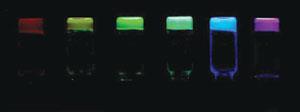Organogels produced in a range of vibrant colours
Organic gels that fluoresce in a wide range of vibrant colours could one day be used in devices ranging from digital displays to photovoltaic cells, according to their Chinese developers.
Fluorescent materials absorb light in the invisible ultraviolet region and then emit light in the visible region. The team, based at Fudan University in Shanghai, designed three naphthalimide-based dyes that can fluoresce in different regions of the visible range - each corresponding to one of the primary colours: red, green and blue. These colours can be combined to make almost any other colour.

’A variety of emission colours can be achieved by changing the concentration and the ratio of the three components in the gel,’ explained Tao Yi, who worked on the project. ’In theory, with a subtle balance, any colour can be obtained.’
Varying mixtures of the dyes were dissolved in organic solvents and then cooled to room temperature to create organic gels, or organogels - a relatively new class of ’soft solid’ materials with unusual properties. These fluorescent dyes also act as gelators - triggering the small molecules in the organic solvent to self-assemble through non-bonding interactions.
The way the molecules stack together in the organogel allows energy transfer between neighbouring dye molecules so they fluoresce brightly even when they’re immobile in the gel.
The gels could fit the requirements for organic light emitting diode (OLED) colour displays or be modified to function as light-absorbing materials to generate power, the team says.
Ross Boyle at the University of Hull, UK, told Chemistry World: ’This system is wonderful in its simplicity, but also very exciting in terms of the different physical and optical properties that can be achieved. Potentially, [it] can yield important information on the complex role of energy and electron transfer processes in light harvesting supramolecular structures.’
Lewis Brindley






No comments yet